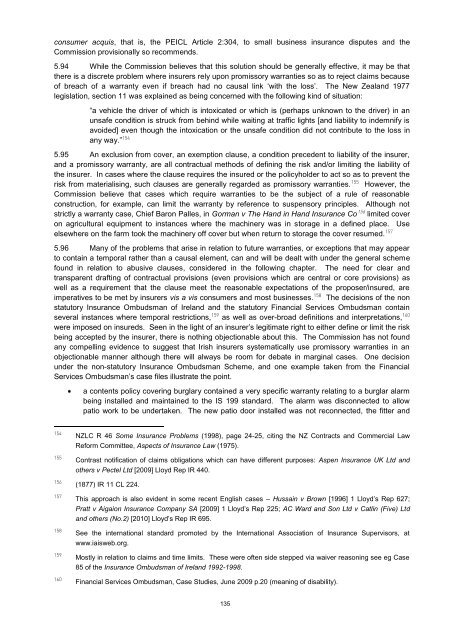Insurance Contracts CP - Law Reform Commission
Insurance Contracts CP - Law Reform Commission
Insurance Contracts CP - Law Reform Commission
Create successful ePaper yourself
Turn your PDF publications into a flip-book with our unique Google optimized e-Paper software.
consumer acquis, that is, the PEICL Article 2:304, to small business insurance disputes and the<br />
<strong>Commission</strong> provisionally so recommends.<br />
5.94 While the <strong>Commission</strong> believes that this solution should be generally effective, it may be that<br />
there is a discrete problem where insurers rely upon promissory warranties so as to reject claims because<br />
of breach of a warranty even if breach had no causal link ‗with the loss‘. The New Zealand 1977<br />
legislation, section 11 was explained as being concerned with the following kind of situation:<br />
―a vehicle the driver of which is intoxicated or which is (perhaps unknown to the driver) in an<br />
unsafe condition is struck from behind while waiting at traffic lights [and liability to indemnify is<br />
avoided] even though the intoxication or the unsafe condition did not contribute to the loss in<br />
any way.‖ 154<br />
5.95 An exclusion from cover, an exemption clause, a condition precedent to liability of the insurer,<br />
and a promissory warranty, are all contractual methods of defining the risk and/or limiting the liability of<br />
the insurer. In cases where the clause requires the insured or the policyholder to act so as to prevent the<br />
risk from materialising, such clauses are generally regarded as promissory warranties. 155 However, the<br />
<strong>Commission</strong> believe that cases which require warranties to be the subject of a rule of reasonable<br />
construction, for example, can limit the warranty by reference to suspensory principles. Although not<br />
strictly a warranty case, Chief Baron Palles, in Gorman v The Hand in Hand <strong>Insurance</strong> Co 156 limited cover<br />
on agricultural equipment to instances where the machinery was in storage in a defined place. Use<br />
elsewhere on the farm took the machinery off cover but when return to storage the cover resumed. 157<br />
5.96 Many of the problems that arise in relation to future warranties, or exceptions that may appear<br />
to contain a temporal rather than a causal element, can and will be dealt with under the general scheme<br />
found in relation to abusive clauses, considered in the following chapter. The need for clear and<br />
transparent drafting of contractual provisions (even provisions which are central or core provisions) as<br />
well as a requirement that the clause meet the reasonable expectations of the proposer/insured, are<br />
imperatives to be met by insurers vis a vis consumers and most businesses. 158 The decisions of the non<br />
statutory <strong>Insurance</strong> Ombudsman of Ireland and the statutory Financial Services Ombudsman contain<br />
several instances where temporal restrictions, 159 as well as over-broad definitions and interpretations, 160<br />
were imposed on insureds. Seen in the light of an insurer‘s legitimate right to either define or limit the risk<br />
being accepted by the insurer, there is nothing objectionable about this. The <strong>Commission</strong> has not found<br />
any compelling evidence to suggest that Irish insurers systematically use promissory warranties in an<br />
objectionable manner although there will always be room for debate in marginal cases. One decision<br />
under the non-statutory <strong>Insurance</strong> Ombudsman Scheme, and one example taken from the Financial<br />
Services Ombudsman‘s case files illustrate the point.<br />
a contents policy covering burglary contained a very specific warranty relating to a burglar alarm<br />
being installed and maintained to the IS 199 standard. The alarm was disconnected to allow<br />
patio work to be undertaken. The new patio door installed was not reconnected, the fitter and<br />
154<br />
155<br />
156<br />
157<br />
158<br />
159<br />
160<br />
NZLC R 46 Some <strong>Insurance</strong> Problems (1998), page 24-25, citing the NZ <strong>Contracts</strong> and Commercial <strong>Law</strong><br />
<strong>Reform</strong> Committee, Aspects of <strong>Insurance</strong> <strong>Law</strong> (1975).<br />
Contrast notification of claims obligations which can have different purposes: Aspen <strong>Insurance</strong> UK Ltd and<br />
others v Pectel Ltd [2009] Lloyd Rep IR 440.<br />
(1877) IR 11 CL 224.<br />
This approach is also evident in some recent English cases – Hussain v Brown [1996] 1 Lloyd‘s Rep 627;<br />
Pratt v Aigaion <strong>Insurance</strong> Company SA [2009] 1 Lloyd‘s Rep 225; AC Ward and Son Ltd v Catlin (Five) Ltd<br />
and others (No.2) [2010] Lloyd‘s Rep IR 695.<br />
See the international standard promoted by the International Association of <strong>Insurance</strong> Supervisors, at<br />
www.iaisweb.org.<br />
Mostly in relation to claims and time limits. These were often side stepped via waiver reasoning see eg Case<br />
85 of the <strong>Insurance</strong> Ombudsman of Ireland 1992-1998.<br />
Financial Services Ombudsman, Case Studies, June 2009 p.20 (meaning of disability).<br />
135

















